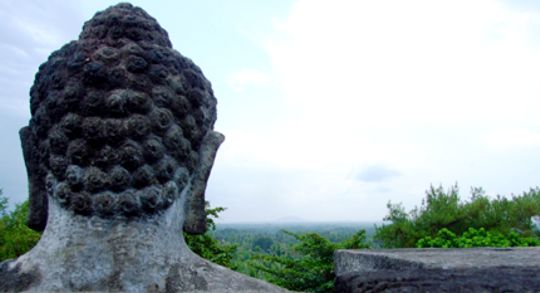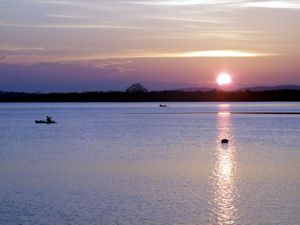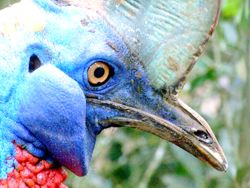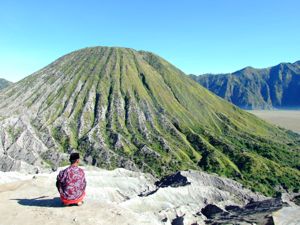
A razor cut to the heart: there is no other way to describe what you feel when you observe from above the archipelagos that look like peeled potatoes. They have been deprived of their luxuriant vegetation and amazing biodiversity just to make western cupboards and produce very low-quality vegetal oil that is sold by European and American markets. Indonesia’s history is very long and we must take some steps backwards to understand it.
The island of Java, just in the south of the equator. Jakarta seems a circle of Hell: you feel like suffocating when you end up being surrounded by reflective skyscrapers, SUVs motorcycles and shantytowns. As soon as you leave the city and go further down south, you can admire rice-fields and the tops of the volcanoes Gede and Pangrango as their background. Life goes by very slowly in villages and the chaos of the capital is noticeable only in the streets where motorcycles and minibuses (known as bemo) whizz. When crossing the long streets full of bamboo houses, it is difficult not to remark the number of children who live in one of the most crowded countries of the world, with its 240 million people (the fourth in the world in terms of density). In Java alone, there are 1000 people per square kilometre. At every corner, there are young women with four or five children and old ladies who cradle new-born babies. It is like ending up into a big nursery. The happy but submissive smile of these people reminds us of their long colonial history. First the Dutch with their disastrous forced cultivation system and then the English who left an inheritance of many years of dictatorship, made Indonesia become a social and, we could say, ecological experiment. This population’s feeling of confusion, after the domination of landlords for so many years, can be noticed in their uncontrollable and growing desire to chase the “western dream”. Even though it had better say that it is a nightmare, not a dream. Just like China and India, this country is making strides, as we can see from the new industrial facilities that often “smoke” along the southern coasts, full of mangroves, and cause not just visual trouble. Understanding how far it is going is not easy at all. There is rubbish everywhere, especially plastics, with a common unawareness of what this could cause. Packing is supplied everywhere, even in the poorest villages around Sukabumi. There is no water available here but you can find an infinite number of plastic glasses with a wide-known French multinational brand that monopolizes the water market. It would be more correct to say that there is water available but it is not drinkable. It is very likely to contract a disease by drinking water from any point of the archipelago. So, the fourth country in terms of density drinks from plastic bottles and glasses with consequences that are not hard to imagine. Among smoky tops and infinite stretches of flooded fields, we see enormous heaps of western polymers. Until a few decades ago, the people in Java, Bali, Sumatra and Papua did not even know about the use of plastics and water was made drinkable as best as they could. The problem about water was undeniable, but instead of dealing with it by trying to improve the sewer system, someone opted for the imposition of the market according to which you buy something to drink and then throw the bottle away anywhere you are; you buy a primary good for ten times more than you would if you made it drinkable domestically. And if this were not enough, you see villages surrounded by mountains of rubbish.
It is difficult to explain all this to Indonesian villagers. Not because they are not intelligent enough to understand it, but because the myth of progress and growth, of satellite TV and motorbikes runs quicker than them. And those who have the power are English, Italian or American brands. To have a deeper understanding of the problem, we will leave the floating glasses on the surface, and get into those little forest areas that have been left in Java. At the extreme western end, we can find the last living species of Java’s very rare Rhino (Rhinoceros sondaicus). It is a shame that the park has become a kind of an isolated blockhouse surrounded by sea and streets. It is still a mystery to understand how this animal with its ridiculously-aphrodisiac horn manages to avoid one of the most absurd extinction. In spite of this, the park is extraordinarily beautiful. 150 km separate it from the nearest protected area. Here, at the feet of Gede volcano, almost 3000 meters high, in the small village of Cikawanga, a recovery centre for the tropical fauna sheltering some rare exemplars of the whole archipelago, survives thanks to small voluntary donations. Snake-eagles, bears, Java’s endangered starlings and orang-utans, arboreal monkeys and Java’s wonderful puma are just some of the most endangered species that are healed and then left free from this centre. This is not an easy task considering that there are no governmental aids and there is very little local staff. In spite of this, we have to admit that false gavials and giant tortoises always have a clean environment and fresh food.
To have a deeper understanding of the problem, we will leave the floating glasses on the surface, and get into those little forest areas that have been left in Java. At the extreme western end, we can find the last living species of Java’s very rare Rhino (Rhinoceros sondaicus). It is a shame that the park has become a kind of an isolated blockhouse surrounded by sea and streets. It is still a mystery to understand how this animal with its ridiculously-aphrodisiac horn manages to avoid one of the most absurd extinction. In spite of this, the park is extraordinarily beautiful. 150 km separate it from the nearest protected area. Here, at the feet of Gede volcano, almost 3000 meters high, in the small village of Cikawanga, a recovery centre for the tropical fauna sheltering some rare exemplars of the whole archipelago, survives thanks to small voluntary donations. Snake-eagles, bears, Java’s endangered starlings and orang-utans, arboreal monkeys and Java’s wonderful puma are just some of the most endangered species that are healed and then left free from this centre. This is not an easy task considering that there are no governmental aids and there is very little local staff. In spite of this, we have to admit that false gavials and giant tortoises always have a clean environment and fresh food.
An episode, not very rare unfortunately, that happened this summer is the unequivocal emblem of Indonesia’s social, political and enviornmental situation. This story highlights the need for international powers to become more aware and take actions to protect Indonesia and avoid that it continues to develop in the same way that has already caused a lot of trouble in the rest of the world.
At around 5 p.m. of a late summer afternoon, the people in charge of the centre receive a call with very bad news. One of Java’s very rare pumas was sent to the police station of the village after having been killed by some people who live nearby the forest.
When the van with the animal keepers arrives, after having spent many hours in the crazy traffic of Sukabumi centre, the plain-clothes detectives, slightly enthusiastic for the event, hand over the still warm animal. No delivery document is minuted. No wonder that the names of those who shot are not even mentioned. This is how it works here, as local operators at the recovery centre confirm. It is not important to know the person who shot and killed the puma as long as he or she stopped the animal from getting too close to the village.
Here we go again. It would be hard to explain to them that that young female puma, now dead, with probably some cubs to feed, is one of the most endangered species of the world and the fact that she was getting closer to villages is due to the loss of habitat and preys, caused by the anthropic pressure.
The bright ebony-black fur has still the perfume of humid forest. We can understand what caused the animal’s death from the holes on her neck and under her abdomen. The autopsy will confirm she received two gunshots and the one that reached her liver was fatal. Looking at those scalpel and scissors cuts makes you feel like wanting to stop that dissection and leave that poor animal intact. Unfortunately, her last breath has long gone. She will not be able to jump and run in the forest again. The word “end” is concealed in her closed eyelids that do not allow to see the brightness of her eyes that stood out against the intense black colour of her head. Nobody can say exactly how many of them are still alive. It has been recently found that this is a separate endemic subspecies (Panthera pardus melas) and not the melanic version of the dark Leopard, already listed by the IUCN among the most critically endangered species.
Some surveys suggest that fewer than 250 mature individuals survive, but according to some researchers they are even fewer than 100. That is why a young female killed near the national park is a very bad loss both for her species and for nature. What seems absurd is the thoughtless way of dealing with such a case by the police and the local population. Although it may be considered as the usual conflicting episode between men and fauna, the future of the protection of nature in Indonesia that has been dealing with a more and more growing population and a not-easily sustainable development, lies in these cases. 147 are the mammals that risk to die out in the whole archipelago and, apart from Java’s panther and rhino, those at risk are also the Sumatran tiger and rhino, Borneo’s orang-utan and tens of little arboreal monkeys that are not widely known.
What seems absurd is the thoughtless way of dealing with such a case by the police and the local population. Although it may be considered as the usual conflicting episode between men and fauna, the future of the protection of nature in Indonesia that has been dealing with a more and more growing population and a not-easily sustainable development, lies in these cases. 147 are the mammals that risk to die out in the whole archipelago and, apart from Java’s panther and rhino, those at risk are also the Sumatran tiger and rhino, Borneo’s orang-utan and tens of little arboreal monkeys that are not widely known.
When dawn comes onto Bromo volcano and the sun reflects itself in the rice-fields, when the green tea-hills surround Borobudur wonderful temples, near Yogyakarta, Indonesia’s cultural capital, on which scenes of Buddha’s life are rock sculpted, it is hard to imagine that hell is hidden in that infinite beauty, in that earthly heaven. It is human hell: people do not have the vital space for a decent existence anymore and species, ecosystems and landscapes are dying. Just as that female panther hid the signs of human destruction under her dark and musky fur, whole islands that were once covered by the biggest tropical forest in the world, second only to the Amazon one, conceal a horrible omen.
This dance of beauty and hell continues in the marine depths. If you cross the strait of Bali, you can have an idea of what happens under the surface. In the sea, among sharks’ fins near the arbor and seagulls behind many ships full of tourists who look for the nicest beach, we find witnesses of human development. Plastics. Everywhere. In one of the most wonderful seas, that can be found in every catalogue and is chosen by tour operators as jewels of the tourist promotion, piles of floating rubbish mount up. On the beaches long white rows of cutlery and bags follow the coast line. It is on the same beaches, in Bali Barat national park, that giant iguanas, ebony monkeys, fiddler crabs with their big claw, and the bizarre lungfish, Periophthalmus, live. Just where real kingfishers feed themselves, dense oils and pieces of polystyrene accumulate every night because of the tide.
For once, tourists are not to be blamed. During the trip on the ferry, it is very easy to remark natives throwing away into the sea the most unthinkable pieces of rubbish.
It is appalling to see that the president of the park, where there is one of the most beautiful coral reefs of the world, is surprised to see the number of turtles, that nest on those coasts, constantly falling. It is an obligation to make him remark that the number of turtles that die of suffocation is stricly related to the quantity of plastic bags thrown into the sea. Even on the faraway Palau Menjangan island, in the north-west of Bali, few turtles have been seen in the last few years.
All this takes us back to our initial thought. How is it possible to deforest islands that are rich in an invaluable biological diversity and populated by endangered species just to plant oil palms? Borneo is undoubtedly the Island that has been most deforested. More than 40% of its forest has gone in just thirty years. At this rate, the levels of deforestation will have so desperately fragmented the island that more than 80% of the endemic species will be at risk. The reason of this absurd violence towards nature lies still in Java, in Bogor wonderful botanic garden. This park, extended by professor Reinwardt, a Dutch botanist, hosts a number of tropical plants and, among them, there is the one that may be the cause of the destruction of the Indonesian forest. It’s in this garden that the oil palm (Elaeis guineensis) was cultivated for the first time. Imported from Africa, it has never left these eastern lands, becoming unfortunately their ruin. The oil that is extracted from this nice palm is the main reason that pushes many European and American multinationals to launch deforestation and low-cost cultivation facilities projects. The extraction of this ingredient that can be found nowadays in any packed product of a supermarket damages the virgin forest. Biscuits, hazel creams, mayonnaise, soaps and balsams…they all contain it. The problem is that we are destroying Indonesia’s enchanting beauty just to satisfy our daily pleasures. The situation is clearer now. We have a constant and uncontrolled growing population that has been chasing the western progress and exploiting, in the worst way, the technologies that already devastated Europe and the United States a long time ago. We also have the multinationals of those colonial countries that have left these territories in chaos and do their best to maximise their profits to produce bad-quality biscuits and high-calorie creams, devastating the enormous splendour of the humid equatorial forest and putting at risk wonderful creatures such as orang-utans. We find immense rice-fields and enough food to feed thousands of every-year newborns, but also forests that get smaller and smaller because of the agricultural pressure. Enchanting beaches for tourists from Paris and surfers from California that hide, behind the few mangrove forests that have not been cut down to build industries, carbon power plants and breeding of crabs, piles of plastics that suffocate the coral reef. One of the nicest and rarest species of the planet that, when hungry, gets closer to villages and becomes a victim of those who, meter after meter, took its forest away from it. Year after year, natives who live in most remote Papua and in Sulawesi struggle to recognize their lands, now colonized by mass agriculture.
The situation is clearer now. We have a constant and uncontrolled growing population that has been chasing the western progress and exploiting, in the worst way, the technologies that already devastated Europe and the United States a long time ago. We also have the multinationals of those colonial countries that have left these territories in chaos and do their best to maximise their profits to produce bad-quality biscuits and high-calorie creams, devastating the enormous splendour of the humid equatorial forest and putting at risk wonderful creatures such as orang-utans. We find immense rice-fields and enough food to feed thousands of every-year newborns, but also forests that get smaller and smaller because of the agricultural pressure. Enchanting beaches for tourists from Paris and surfers from California that hide, behind the few mangrove forests that have not been cut down to build industries, carbon power plants and breeding of crabs, piles of plastics that suffocate the coral reef. One of the nicest and rarest species of the planet that, when hungry, gets closer to villages and becomes a victim of those who, meter after meter, took its forest away from it. Year after year, natives who live in most remote Papua and in Sulawesi struggle to recognize their lands, now colonized by mass agriculture.
The contrast between beauty and hell in Indonesia has deep roots and deserves deep reflections. Of course, one of the most worrying trends is the uncontrolled rise of the population. The impact of 1000 people per square kilometre is not the same as the one of 500 or 50 people. One of the most immediate interventions to protect Indonesia’s beauty and the peoples who live in it from a development idea that is closer to self-destruction rather than wellness, is –just as it has been done in many developing countries- creating strategies to reduce the birth rate. This has to be done not with coercive impositions of big powers, as it happens unsuccessfully in the not very democratic Chinese system, but with a series of actions that aim at improving women’s social condition, at spreading contraceptive methods and increasing the education rate (still too low), by teaching subjects such as environmental, sexual and health education.
With fewer mouths to feed but more aware of the development method to follow, the environment and the natives may catch back the necessary time to avoid extinction and protect one of the most enchanting places of the world.
By Roberto Cazzolla Gatti
Photographs by Roberto Cazzolla Gatti
Translation by Mauro Cazzolla











